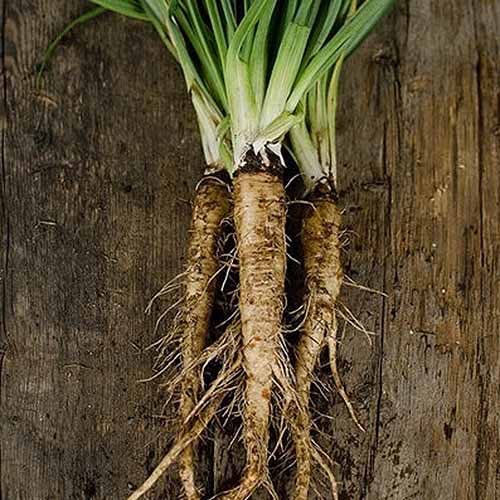Tragopogon porrifolius
I just don’t understand why certain plants aren’t more popular.
I’m so happy that edible flowers are finding a foothold, and extra spicy chilis are practically a veggie garden staple. But some vegetables still don’t have the following they deserve.
Salsify is one of those plants. It’s delicious, resistant to most pests and diseases, and has a flavor that tastes like nothing else.
You can store the roots for a good long time, and you’d better believe they’re versatile in the kitchen.
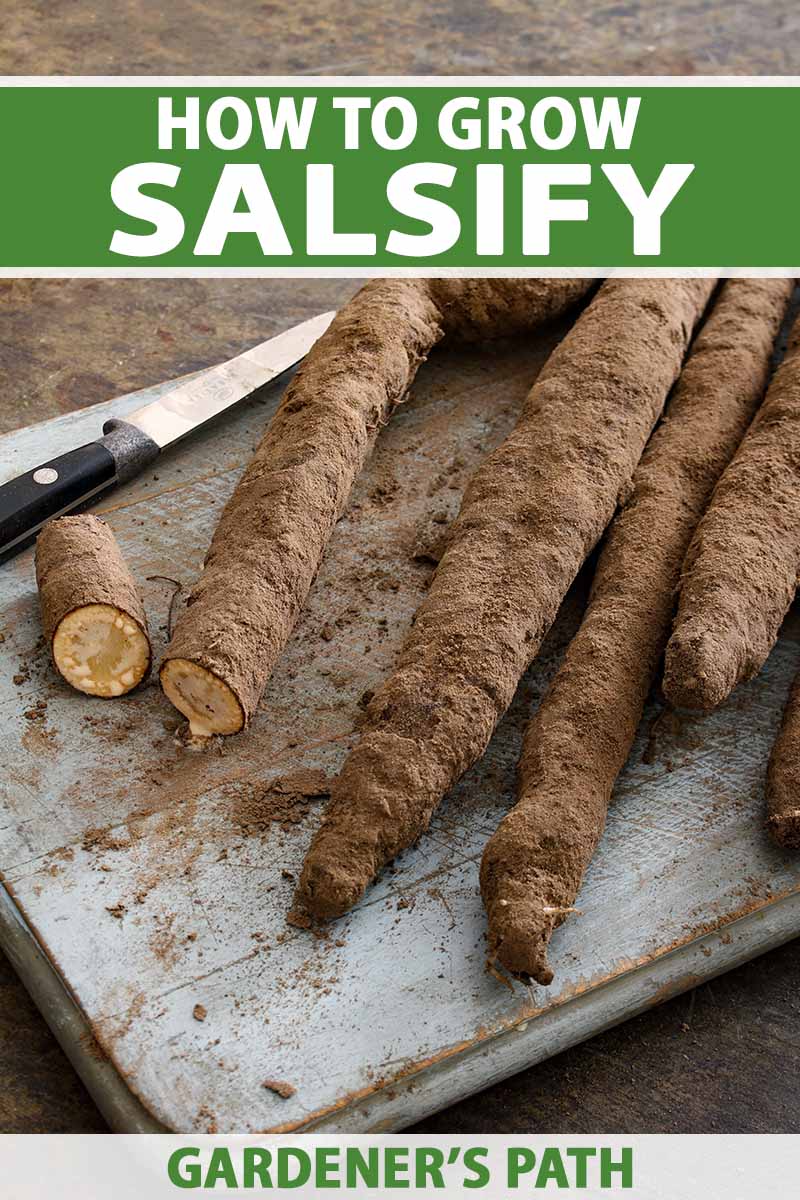
We link to vendors to help you find relevant products. If you buy from one of our links, we may earn a commission.
In case it’s not clear already, I love salsify. I remember the first time I tasted it, and I resolved to make it a part of my garden immediately.
I didn’t realize that the seeds can be a bit finicky and the plants need a long time to mature in cool weather.
Needless to say, my first attempts weren’t impressive. But I persevered because I wasn’t about to live without the marvelous roots. Now I’m a salsify pro, and I’m going to help you to become one, too.
In just a sec, we’ll go over the following to make growing salsify a breeze:
What You’ll Learn
Salsify grows well in USDA Hardiness Zones 5 to 9, and it needs a long period of cool weather to thrive. In the right location, you can pretty much plant it and forget it.
Ready to dig in?
What Is Salsify?
Salsify (Tragopogon porrifolius), not to be confused with false or black salsify (Scorzonera hispanica), is a plant grown for its edible root.
In this guide, we’ll focus on the former rather than the latter species, but they can be used interchangeably in the kitchen and they are related.
Hailing from the Asteraceae family, T. porrifolius is related to chicory and dandelion and looks quite similar. It’s a biennial, but most of us grow it as an annual.

Salsify is one of those plants that serves multiple purposes.
The purple or yellow flowers, which resemble a darker chicory, are an ornamental addition to the garden.
In addition to being edible, they’re also attractive to pollinators. The flowers eventually give way to dandelion-like seed heads that disperse in the wind.
The leaves don’t resemble those of chicory or dandelion, though. They look quite a bit like tall grass, as they’re long and strappy, reaching up to four feet in height.
The root looks like a thin, white carrot, but the flavor is nothing like a carrot. With a hint of ocean flavor that’s slightly mineral-esque, it has a similar flavor to the brine in mild oysters.
I’ve also heard it compared to asparagus or parsnip. I think it depends on when you harvest it and what conditions it grows in.
Cultivation and History
Oyster plant, Jerusalem star, vegetable oyster, goatsbeard, or purple salsify – whatever you call it, this species originated in the Mediterranean, where it was foraged and cultivated by the ancient Greeks and Romans.
Good old naturalist Pliny the Elder mentioned it in his writing several times.
By the 1500s, it was widely cultivated throughout Europe, and by the 1700s, it had reached the New World.
In the Victorian era, this veggie had reached its peak popularity in the New World. Since then, it’s fallen off menus a bit.
You could find recipes for it in the first edition of “The Joy of Cooking,” but it was never as ubiquitous as vegetables like potatoes or carrots.
When refrigeration became widely available, people turned away from certain long-storing root veggies, and salsify all but vanished. What a shame. But you have the power to turn things back around in your garden!
Salsify Propagation
You’ve got one option if you want to grow salsify, and that’s to get your hands on some seeds. These plants can’t be grown via division, cuttings, or transplanting. So, seeds it is.
Thank goodness it’s fairly straightforward. Timing is going to be your biggest challenge.
This veggie needs up to 150 days with temperatures under 85°F to mature, so you might need to get a headstart on the growing season.
You have two options: start seeds outdoors a few weeks before the last predicted frost date, or start seeds indoors in five-inch compostable pots eight weeks before the last frost date. Compostable pots are key because you don’t want to disturb the developing taproots.
If you live in a region with mild winters, you can plant salsify in the fall and harvest in the spring. In Zone 8, for instance, you should put seeds in the ground in early November.
Plant the slender seeds an inch deep, one per pot, or spaced nine inches apart outside.
Water the soil carefully so as not to disturb the seeds and keep the soil moist, but not soggy, as the seeds germinate. If you’re propagating indoors, place the pots under grow lights for eight hours per day.
If you’ve started the seeds in pots, take them outside to harden them off a week or so before the last predicted frost date. If you’ve never hardened seedlings off before, it’s pretty simple.
Take the plants outside for an hour and let them hang out in a protected area in the sunshine. Then, take them back inside to the safety of the indoors. The next day, take them outside for two hours, and on the third day, three hours.
Noticing a pattern? Keep doing this, adding an hour each day, for a week. At that point, you can plant the seedlings in the ground.
Gently rough up the bottom of the container and dig a hole in prepared soil. The growing soil needs to be extremely well-draining and loose.
Seriously. As loose as you can manage. It’s hard to harvest the roots without breaking them, and loose soil will make all the difference.
The best method of loosening up soil is to work in tons of well-rotted compost at least a foot deep.
You can also grow salsify in containers filled with water-retentive potting soil, but the container or raised bed needs to be at least a foot deep.
How to Grow Salsify Plants
There are two challenges when growing salsify.
The first is that it needs cool weather for about 150 days to mature. People who live in regions with a long, hot summer are probably not going to be able to succeed with these plants.
The other challenge is harvesting, which we’ll talk about shortly. For now, let’s focus on growing conditions.
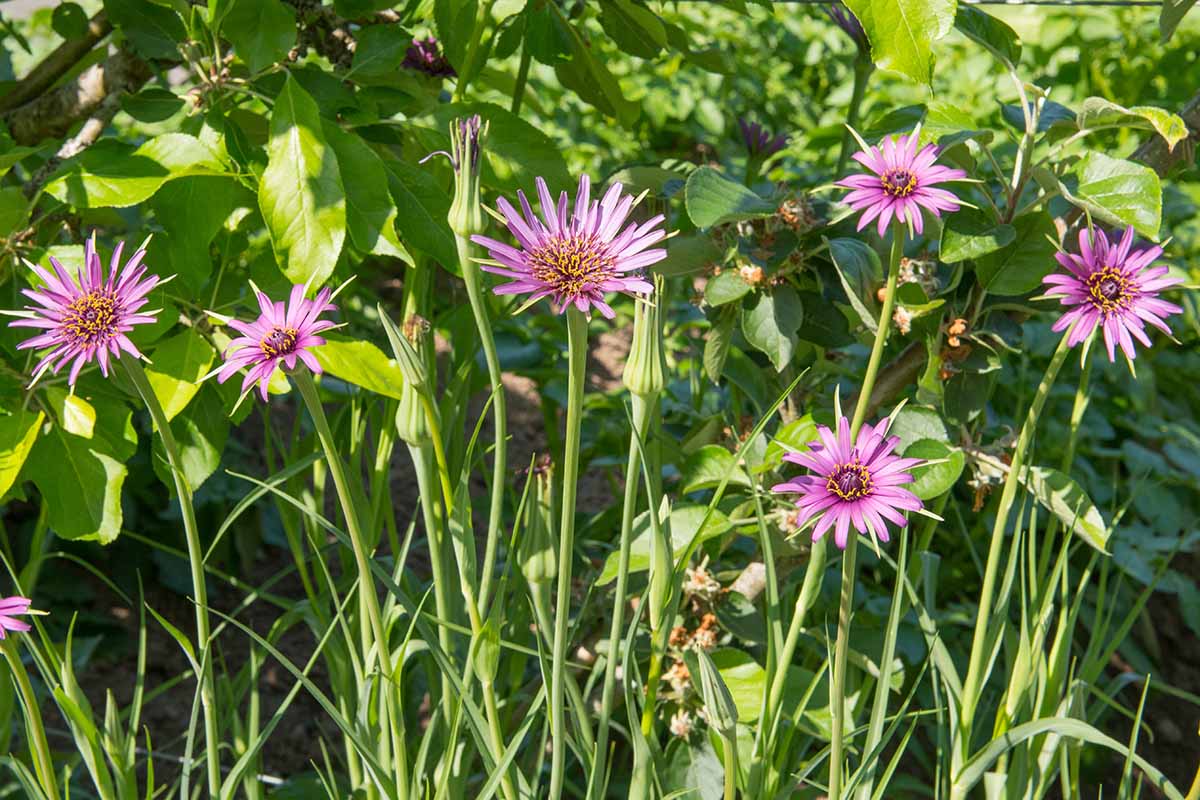
To make life easier come harvest time, and to ensure the longest, widest roots possible, ensure the soil is extremely loose.
I live in a region with heavy clay, so I grow mine in deep pots filled with an extremely light potting soil.
You wouldn’t want to grow a tree in super light soil because it’s too loose for the roots to find support. But it’s perfect for root veggies like potatoes and salsify.
I use FoxFarm’s Lucky Dog because it’s full of nutritious stuff like earthworm castings and beneficial mycorrhizal fungi, plus ingredients like peat moss and perlite to make the soil loose and light.

Compressed 2.2-cubic-foot cubes are available on Amazon.
If you aren’t cursed with heavy clay, feel free to grow yours in the ground. Just work in a ton of well-rotted compost or a soil conditioner like FoxFarm’s Happy Frog Soil Conditioner.

FoxFarm Happy Frog Soil Conditioner
Amazon carries this fantastic product, which contains worm castings and healthy soil microbes, in 1.5-cubic-foot bags.
The secret to growing good roots is in the water. The roots need consistent moisture, not too much and not too little.
The easiest thing to do to test the soil moisture is to stick your finger in the soil. If it feels dry below your first knuckle, it’s time to add water. Don’t let the soil get soggy, though. That will drown the roots.
The only thing you need to do in terms of maintenance while your salsify is growing is to prune off any dead leaves. These are just a drag on the plant. Get rid of them.
Growing Tips
- Plant when you’ll have about five months of cool weather or start seeds indoors.
- Roots need loose, rich soil. Amend the soil or plant in a container.
- Water when the top inch of soil dries out.
Salsify Cultivars to Select
There aren’t a ton of salsify cultivars on the market, but there are a few, and they’re awesome. Here are the most common varieties:
Fiore Blu
‘Fiore Blu’ has a beautiful purple-blue flower and the root itself is milder than the species. Otherwise, it’s extremely similar.
If you want something somewhat ornamental and not too aggressive in flavor, pick up some ‘Fiore Blu.’
Mammoth Sandwich Island
‘Mammoth Sandwich Island’ is unsurprisingly large, with roots that can reach up to 10 inches in length and an inch in diameter.
They’re tapered, giving them the appearance of a white carrot or parsnip, though the flavor is all salsify.
It’s not just that the larger roots give you more to munch on, but they’re also less prone to snapping as you’re attempting to harvest them.
Seeds are available from Eden Brothers and True Leaf Market.
White French
‘White French’ is an heirloom that can be a little hard to find, but if you do, the slender, pale roots are full of flavor and reliably reach up to six inches long.
Managing Pests and Disease
If you’ve ever grown a vegetable that seemed to be constantly fighting off bad bugs or nasty diseases, growing salsify is going to be a nice change of pace.
It’s pretty rare that something comes along to trouble these plants, and when something does, it rarely threatens your harvest.
Let’s talk about pests first.
Insects
Aphids are common garden pests but they only casually feed on salsify. If there’s nothing better around, they will nibble on it, though.
Carrot rust fly infestations aren’t super common either, but they can be much more damaging.
Aphids
If you were hoping that salsify escapes the aphid plague, I’m sorry to disappoint.
Bean (Aphis fabae), green peach (Myzus persicae), pea (Acyrthosiphon pisum), and potato aphids (Macrosyphum euphorbiae) will all feed on salsify, leaving the leaves speckled and potentially reducing the plant’s vigor if an infestation is large enough.
Generally, you can control the problem by spraying off the leaves with a gentle blast of water.
Do this for a few days in a row, and things should be taken care of. If not, read our guide to aphids for more tips.
Carrot Rust Flies
Carrot rust flies (Psila rosae) are tiny, but boy are they nasty.
The larvae will feed on the roots of salsify, leaving rotten tunnels behind as an unfortunate surprise at harvest time. And that’s assuming that they don’t kill the root outright.
These tunnels leave the root exposed to disease, and they can render your harvest inedible.
Beneficial insects and protective netting are the gold standard in prevention. Learn more in our guide to identifying and controlling carrot rust flies.
Disease
Salsify is tough, and it’s unlikely that you’ll ever experience problems with disease.
But seeing ailments strike rarely is not the same thing as never encountering harmful pathogens that may affect your crop. Be on the lookout for white rust, just in case.
White Rust
White rust is a disease caused by an oomycete called Pustula tragopogonis (formerly Albugo tragopogonis).
It infects sunflowers (Helianthus annuus), goatsbeard (Aruncus dioicus), and, you guessed it, salsify. It spreads in water and can live in the soil, thriving in humid weather under 70°F.
It causes crusty, raised, white lumps all along the underside of the leaves, eventually causing them to collapse.
Sunflowers are a host, and pests like aphids can carry it. If you really want to avoid this problem, don’t plant sunflowers nearby and do your best to control aphid populations.
Since it won’t usually kill your plant, just trim off the infected foliage and rotate your crops regularly. Don’t plant sunflowers or salsify in the same spot more than once every three years.
Harvesting Salsify Roots
Harvest those roots before any flowers form! Once the flowers start blooming, the roots become tough and bitter.
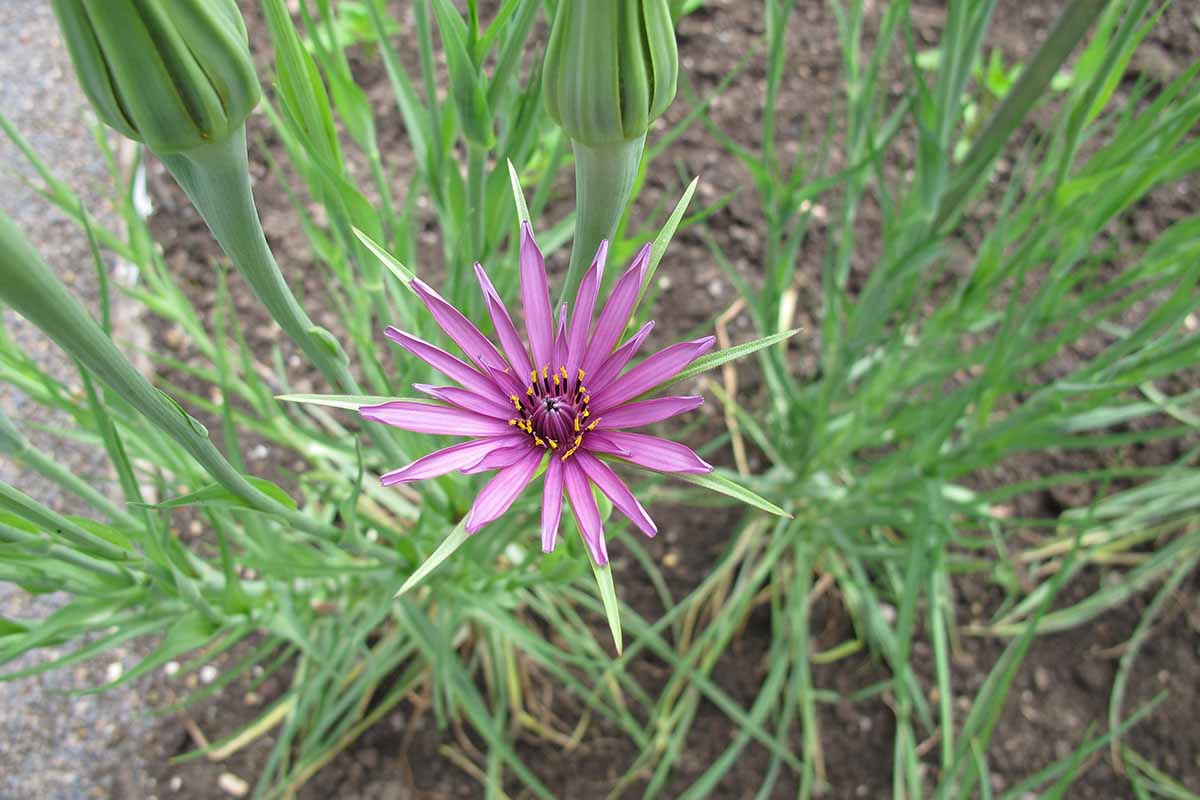
The same goes for the leaves. Chomp into those before the flowers form because that’s when they’re tender.
Since the flowers don’t form until the second year of growth, most of us who grow these veggies as annuals won’t have to worry.
To harvest the leaves, just cut a few here or there in the morning when they’re full of water.
Don’t overharvest or you’ll compromise the root. Never take more than a third of the leaves at a time and let them regrow before you take more.
Of course, if you want to eat the flowers, you have to let them develop. Pluck them when they’re fully open in the afternoon.
If you want to harvest seeds, let the plant go dormant over the winter and then harvest the seeds after they form post-bloom the next growing season. They should be tan and hard when they’re ready.
Now, for the hard part. Remember how we talked about needing loose, loose, loose soil? This is where that prep pays off.
Harvesting the roots whole is challenging. They’re often thin, and they want to break as you tug and wiggle them out of the soil.
To harvest, use a garden fork or knife. I prefer to use a hori-hori knife because it gives me the leverage and maneuverability I need to work the roots out whole.

Barebones Classic Hori Hori Knife
I like my Barebones Classic because the handle has a nice grip to it, and the stainless steel blade is thick and sturdy. If you’d like one for your toolkit, they’re available at Amazon.
Once you have your tool, dig all around the clump to loosen everything up.
Then, grip the leaves at the base and gently pull as you use your tool to lift up the roots. If you feel resistance, stop and do a little more soil loosening.
Remember, don’t let the plant flower before you harvest. If you do, make sure to cook those older roots well.
Preserving Salsify Roots
Brush the dirt off the roots, don’t wash them, and wrap them in a paper towel.
Stick this inside a ventilated plastic bag and you can place the roots in the refrigerator crisper drawer for a few weeks.
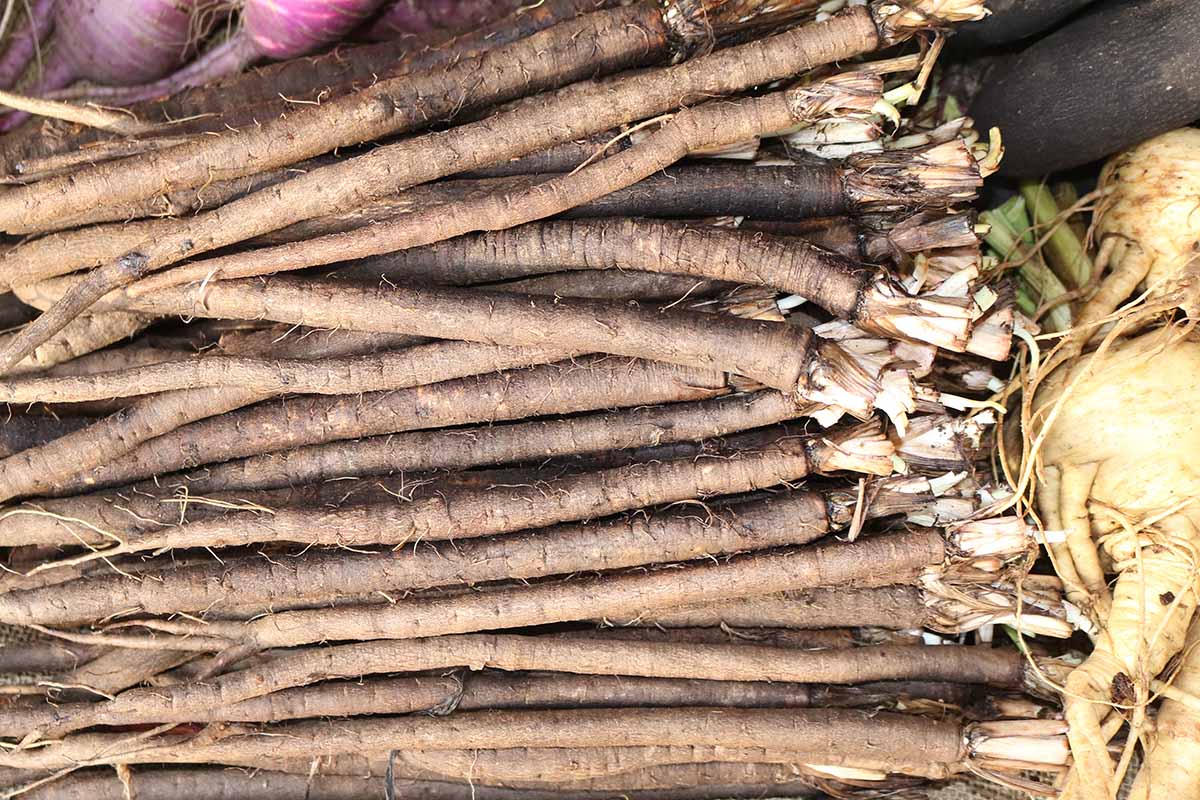
You can also store the roots in sand in a root cellar. They’ll last this way for a month or so.
Wait to wash until just before using to prevent rot.
Salsify can be dehydrated, but it loses flavor. Still, it’s better than losing the root altogether to the ravages of time.
Slice the cleaned roots a quarter-inch thick and dehydrate them in an electric dehydrator, or in a single layer on a baking sheet at the lowest heat setting in your oven.
Stop when they’ve attained a crisp texture and have turned tan.
You can also freeze the roots. Slice them into chunks, quickly blanch them in boiling water, and then shock them in ice water.
Pat them dry and place them in sealed bags with the air pressed out. The roots will need to be used in recipes like soup because they turn soft as a result of this process.
Recipes and Cooking Ideas
I love ocean-flavored vegetables. My favorite veggie in the whole world is the sea bean, aka pickleweed or glasswort, and salsify is a close runner-up.
It doesn’t taste fishy, but it does have a flavor that is reminiscent of the sea.
Since neither I nor my wallet can support a daily oyster habit, I get my fix by slicing the roots about a quarter-inch thick and roasting them in oil in the oven to make chips. You might toss in some garlic cloves or some dry herbs like thyme or oregano.
Cook until they reach the texture you prefer, and then toss them in a bit of salt and chopped parsley. If you want, serve with lemon wedges so diners can squeeze a bit on as they eat.
If you prefer fries rather than chips, you can cut the roots into sticks instead of coins.
For a fresh snack, shred the roots and toss them in a vinaigrette. Throw in some shredded carrots and green onions if you want.
You should always cook older roots. Nothing bad will happen if you eat the older roots, except they’re tough and not too appealing to gnaw on. Young roots can be eaten raw without threatening your dental work.
If you’ve ever made creamy parsnip soup, use salsify instead for a different flavor.
Or boil the shredded roots and mix them with a little mayo and spices, pack them into patties, and roast them in some butter in a pan to make veggie “fish” cakes.
If you let the plant flower and go to seed, those slender seeds can be soaked in water until they sprout. Add the sprouted seeds to salads and soups. The greens can also be sauteed in a pan with butter.
Quick Reference Growing Guide
| Plant Type: | Biennial root vegetable | Flower/Foliage Color: | Purple, yellow/green |
| Native to: | Mediterranean | Water Needs: | Moderate |
| Hardiness (USDA Zones): | 5-9 | Maintenance: | Low |
| Bloom Time/Season: | Spring-fall | Tolerance: | Frost |
| Exposure: | Full sun | Soil Type: | Loose, rich |
| Time to Maturity: | 150 days | Soil pH: | 6.0-6.8 |
| Spacing: | 9 inches | Soil Drainage: | Well-draining |
| Planting Depth: | 1 inch (seeds) | Attracts: | Pollinators |
| Height: | 4 feet | Order: | Asterales |
| Spread: | 18 inches | Family: | Asteraceae |
| Growth Rate: | Moderate | Genus: | Tragopogon |
| Common Pests and Diseases: | Aphids, carrot rust flies; white rust | Species: | Porrifolius |
Say Yes to Salsify
Move over beets. It’s about time a new root veggie moved in.

Salsify is far more versatile than most people realize, if they even know what it is. And if you can grow carrots, you can grow salsify!
How do you plan to use your harvest? Share your cooking tips with us in the comments.
Root vegetables rock. Looking for a few more to add to your garden? Check these out next:
